Tuesday, June 2, 2009
Today
Today I think I might get my hair cut. It's bothersomely long . . . for my tastes. It gets in the way. Besides that, it could use some shaping/styling.
I also have some university business to attend . . . sign a paper, get a class cleared and see about getting more funding for next semester. Speaking of school, I now have a non-thesis project that is reasonable enough to allow me to graduate next spring as planned. :) Sometimes I impress and/or suprise myself with what I accomplish . . . a masters of science . . . maybe I shouldn't toot my horn about a year in advance.
Thursday, May 7, 2009
Final Project
Maps show a variety of phenomenon within a spatial context. These to project maps shall show two very different, but interesting spatial features. Map 1 is a depiction of counties in Idaho with household sizes above and below the state’s mean household size. Map two is a multivariate map that shows the range of a lighthouse beam along with the varying ocean depths where the light may reach as well as surrounding waters.
Background
Map 1 displays average household size in each Idaho County and whether that county is above, or below the state average of 2.71 people per household. Values seem higher in the south and especially southeast portions of the state. This means that the average household is higher than the state average of 2.71 people per household.
This map is not meant for high end analysis. It can be used as a general, fast reference. This map was not designed for the purpose of textbooks, although it could be used for a human geography textbook, showing geographic phenomenon of social norms related with certain people groups. Map viewers should be able to see the trend over the state and understand where greater than or less than average values occur. My data was not adequate to establish an absolute conclusion.
Map two is a reference map showing the beam range of Highland Light on Cape Cod, Massachusetts mapped over nearby oceanic depths. Lighthouses are a navigational aid of mariners, as such, mariner are concerned about ocean depth and light visibility. This map shows that this lighthouse is easily visible in deep water, avoiding risk of sandbar grounding of vessels.
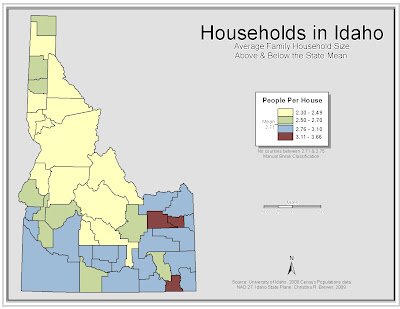
Map 2
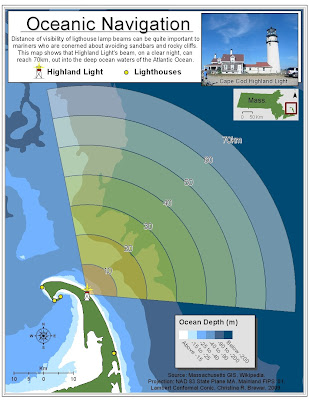
Wednesday, April 22, 2009
Map of the Week - National Public Lands Day
The National Public Lands Day web site contains a simple map of the U.S. Clicking on a state will do two things: tell you that state does not contain any sites, or direct the browser to a new page containing information about public lands day sites in that state. The info includes thing such as contact phone number, related website, directions, and a link to a locational map. Perhaps quite a useful tool for those interested in being involved with National Public Lands Day.
Please the following link to see this week's interactive map of the week.
http://www.publiclandsday.org/involved/sites.htm?
Exercise 7

Population Density & Elderly Populations
The following map shows elderly population in Idaho counties using graduated symbols. County population density is portrayed in darkening shades of blue (county background). The map shows a higher number of elderly in the south and northwest portions of the state. The map shows some counties with low population density, but higher numbers of elderly. This may be partially due to density being a function of county size.
The map is limited in the fact that it does not display elderly density, but rather raw quantities. This map give a deceptive picture of the percentage of elderly in each county.

Wednesday, April 15, 2009
Map of the Week - Wood?
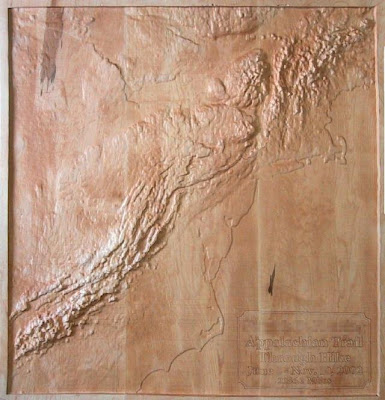
Source: http://www.cbsled.com/relief_maps.html
Exercise 6
Annual Precipitation - Kriging
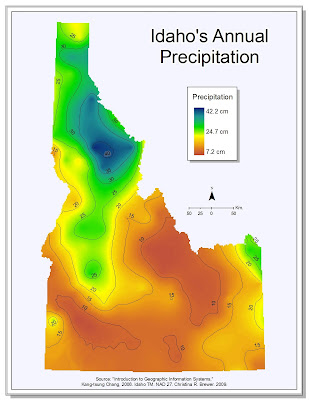
Tuesday, April 7, 2009
Excercise 5
The map layout is somewhat simple in color with some smaller embellishments (legend drop shadow, subdued N. arrow, title masking). I experienced some trouble in working with the legend and related dots for label boxes. I changed the project to a state plane that seemed to better portray the state of Idaho.

Capital City Populations
For this map I decided to leave the legend is frameless, perhaps helping to more closely associate symbols with features. The north arrow is more decorative than my typical choice but perhaps more typical of global mapping. Map elements were used to help sort of frame the globe (legend, credits, N. arrow). I experienced some trouble due to my inexperience with graduated symbol mapping.
Hawaiian & Pacific Islanders, Buffalo NY.
In this map I made use of some color, and a more decorative symbol for the proportional map symbol of this map. I did experienced some trouble in setting up proportional symbols partially due to my lack of experience in this area of map making.
Monday, April 6, 2009
Map of the Week - Lechuguilla Cave
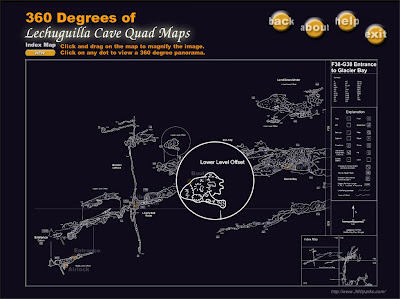
Tuesday, March 31, 2009
Map of the Week - Portland, Maiine
http://www.sullboat.com/portland%201876%20birds%20view_m.jpg
The Map
This work is of Portland Maine from a "bird's eye view," showing the city from a side angle. The streets are labeled and various eastablishments numbered with indentification in the lists below the main map. This was published in 1876 as the workmanship of Jos. Warner.
Maps – Originals Re-Invented
This post contains orginal and revised maps from geovisualization exercises 1 through 3.
The first part of each section contains a heading followed by a bit of info about that two maps to follow. The first map is the orginal version followed by a list of some, or all of the aspects of the original map that were changed. The last item in each section is a copy of the revised map.
Please feel free to post comments and questions. Enjoy!
Race Dominance, Buffalo
The following two maps depict dominant races in land tracts of Buffalo. The first map was the originally submitted version. The map is somewhat satisfactory in this form. However, the second map includes additional edits, hopefully improving the map in depicting the qualitative phenomenon of race dominance. I attempted, but failed to properly project the layers. I was able to define the layer’s geographic coordinate system.
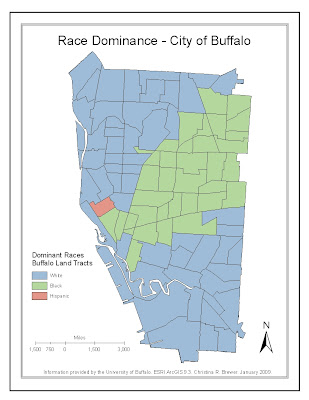 Changes
ChangesNeatlines
Title - appearance
Legend - Title, frame, and text and object sizes
Scale bar – Thicker, and unit more centered over zero
North arrow – reduced size
Credits – Edited
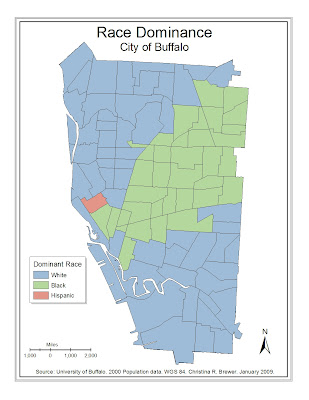
The next two maps depict population distribution of individuals 5 to 17. These children may, or may not be enrolled in school. We can say, however, that they are within the school age group in the U.S. This is the same layer used in the previous maps, and is also not properly projected.
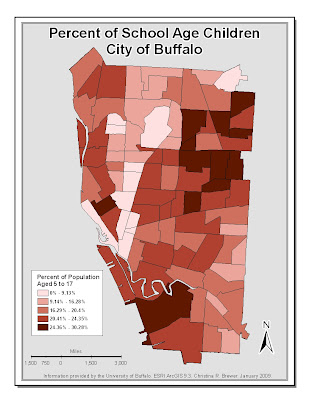 Changes
ChangesI wanted to make this map look more child-like since it depicted school age children values.
Area between two neatline – added blue background
Title – edited phrasing and masking color
Legend – Background color, created color ramping, removed “%” from labels (it’s in the title).
Scale bar – reduced size and line thickness, more centered unit title.
North arrow – Edited masking
Credits – Edited
Background – Color change
The following two maps show the shrinkage of Nez Perce reservation lands beginning with the aboriginal land up to the 1863 borders, as well as land ownership in 2006.
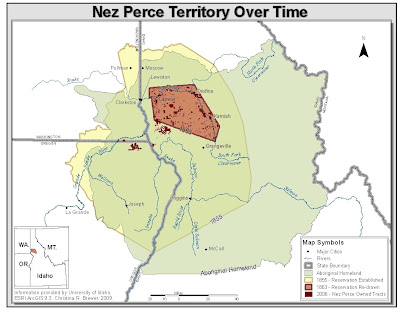
Title – Changed the mask color, removed bold font
Scale bar – added to inset
North arrow – reduced and moved further into the upper right corner, also added one to the inset
Credits – Edited
Inset – Refocused extent
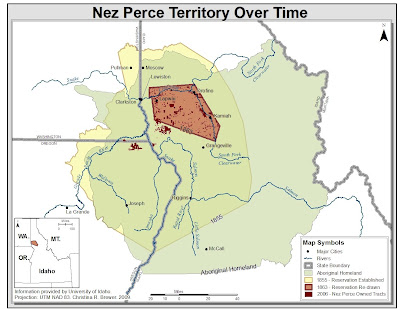
The following two maps are examples of ArcGIS’s capability to simplify lines for cartographic, or other mapping purposes. The map shows the river of interest both regionally, semi- locally, and also close up.
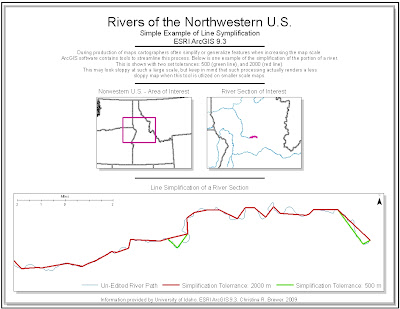 Changes
ChangesNeatline – Reduced gap between each, and added a background color
Legend – changed position and format, perhaps making it more visible at a quick glance
Scale bar – added to insets and increased length in main map
North arrow – added to insets
Credits – moved up a little
Insets – edited attention color, now perhaps better matching with the map
This first map was created using Macromedia Freehand software. The map lacks many of the important map elements, such as a legend, scale, and north arrow. Freehand is not a geographically interfaced software. The first map was created with some attempts to adhere to the given lab directions with less attention to my personal map design preference.
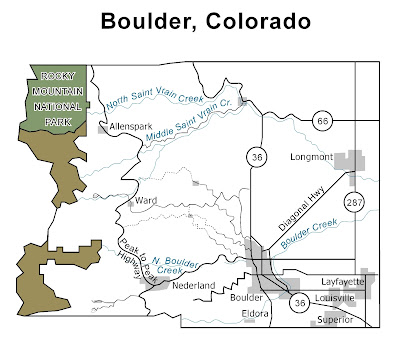 Changes
ChangesThe edited map was altered in ArcMap by added the jpg and working within the ArcGIS environment.
Neatline – added
Labels – added to Indian Peaks Wilderness, and dealt with “Highway” below the feature.
Credits – added a small credit
The following two maps depict average family size within each state using four different methods for classifying data. Five classes were used for each map.
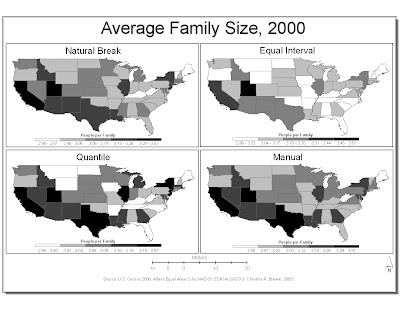 Changes
ChangesTitles – Changed the font to Times New Romans. I believe this creates a better look to the map.
Scale bar – Reduced size, and more centered the unit title
North arrow – moved down, and left a little
Credits – Moved down a little
Projection – Alber’s Equal Area Conic is an improvement from the previous. However, the scale bar showed that something was wrong with the projection. Tried, but did not get it fixed.






